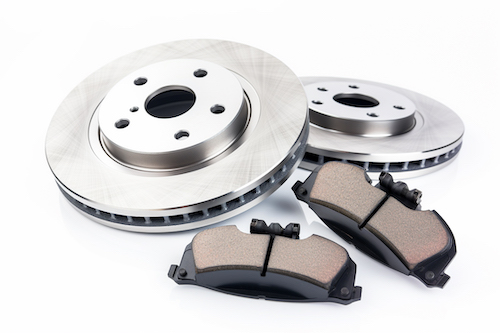Brake Pads 101: Understanding Your Braking System & Its Key Component

Brake With Confidence at Tate Boys Brake Shop & Auto Center
Some drivers know that their brake pads need to be replaced but don’t know how often they need to get this service done. This leads to many drivers continuing to drive their vehicles, not knowing that they have low brake pads.
At Tate Boys, we want your vehicle to be as safe as possible while it's on the road, which is why we provide tips to help you avoid costly brake repairs. Let’s take a look at your vehicle's brake system and find out how to tell when it's time for brake pad replacement and when it's time for brake repair.
Your Brakes Are a Vital Component of Your Vehicle
Your brake pads are responsible for bringing you to a stop every time you hit the brake pedal. When you hit the pedal, they work silently to slow you down and are even sometimes used automatically by your traction control system to prevent sliding. However, when your brake pads wear thin, they can jeopardize your vehicle’s stopping power, potentially leading to a collision. Many vehicles do not have brake pad sensors to notify you when your brake pads have worn to their minimum thickness, so it's your responsibility to make sure that you have adequate pack thickness on your own.
While there are telltale signs such as squeaking or grinding brakes, some drivers are simply unaware that their brake pads have worn thin and continue to drive normally. Continuing to drive with worn brake pads can lead to extensive brake repair costs.
How Your Brake System Works
When you depress the brake pedal, your master cylinder sends fluid through your brake lines and into your calipers. Your calipers hold your brake pads and are responsible for applying pressure against them to clamp down on your rotors. This sequence is what brings your vehicle to a stop.
Your brake pads are made of a high-friction material that wears down over time. When your brake pads reach a minimum thickness, they are no longer capable of bringing your vehicle to a stop properly — which is why they must be changed once they wear thin.
How To Know When it's Time for Brake Pad Replacement
There are a few ways your vehicle may be telling you that you need brake pad replacement:
Warning Lights
Some vehicles are equipped with brake pad sensors that trigger a warning light when your brake pads wear thin. While this feature isn't in every car, for those that do have it, a warning light will be one of the first signs of thin brake pads.
Squeaking
Squeaking brakes are another common sign that your brake pads are wearing thin. If you notice squeaking noises when you depress your brake pedal, it's possible that your brake pads are wearing thin, and it's time for brake pad replacement.
Extended Stopping Distance
When your brake pads get hot, they are unable to work as intended. Because thin brake pads get hot quickly, they tend to perform especially poorly. If you notice that your vehicle is struggling to stop, it's possible that your brake pads have worn thin.
How To Know When You Need Brake Pad Repair
Vehicle Vibrating
If you notice your steering vibrating when you depress the brake pedal, it's possible that your brake rotors have warped, and you’re in need of brake repair. Brake rotors can warp under extreme stress. This can happen from excessive heat that can occur during racing and emergency braking situations. Your rotors can also become damaged if your brake pads have worn too thin but have not been replaced.
Warning Lights
If your vehicle senses a problem with your brake system, you may see a Service ABS warning light. This warning light is a key indicator that you need brake repair, as it can be triggered by something like a failed master cylinder or low brake pressure.
Vehicle Pulling to One Side
If your vehicle is pulling to one side, it's possible that one of the components of your brake system has malfunctioned or worn unevenly. Sometimes, in emergency situations, avoidance maneuvers can damage your brake rotors.
Brake Service
Here’s an example of what your vehicle’s brake maintenance schedule should look like to minimize the need for brake repair over time and ensure that your vehicle has the safe stopping power you’re used to:
- Brake pad replacement — every 15,000 to 80,000 miles
- Brake rotor replacement — every 50,000 to 80,000 miles
- Brake fluid flush — every three years or 45,000 miles
Maintain Your Stopping Power With Tate Boys
At Tate Boys, we go the extra mile to handle all your brake repair and brake pad replacement needs with care. We feature a team of ASE-certified mechanics who use high-quality brake pads and rotors to ensure that your vehicle always has the stopping power to be safe on the road. We strive to make your services affordable, which is why you'll find fantastic service coupons that help you save big on everyday services.
Request a service quote today and let Tate Boys handle all of your brake repair and brake pad replacement needs.



